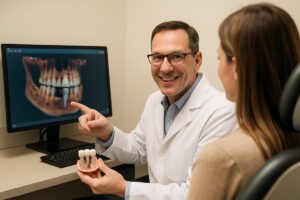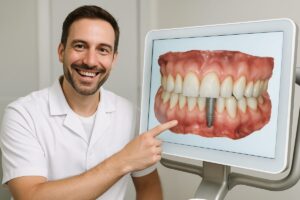Healing Phases After Dental Implant Surgery
Scheduling your dental implant is an exciting step in your journey to a beautiful new smile. Generally, the implant procedure has two healing phases. Understanding how long these phases may take to heal, will help you plan your recovery.
Here’s an overview of the healing process, and what you can do to prepare for your dental implant!
Dental implants consist of three components: a screw-like “root,” an abutment, and a tooth-shaped crown. Most patients will undergo two procedures to have their implants placed. The first procedure involves placing the screw into the jawbone. Inserting the screw creates a stable base for the implant. After insertion of the screw into your jawbone, the area around the root will need to heal, in a process called osseointegration.
Once your bone has healed around the root, a second procedure is performed. This time, an abutment is placed into the root. This second phase requires less healing time, since it is a minimally invasive procedure. After you have healed from the abutment placement, the crown can be placed atop the abutment.
The surgery site after root placement typically heals within a few weeks to several months, however full osseointegration may require many months. Full osseointegration is dependent on the number of implants placed and your overall health. The second phase, after the abutment is placed, typically heals within a couple of weeks.
Your dental implant healing process can vary due to several factors. If your jawbone isn’t dense enough to support an implant root, you may need a bone graft. Bone grafts strengthen your jawbone by adding density. If a bone graft is necessary, it will significantly lengthen your overall healing timeline.
Gum disease, lifestyle habits, certain medications and health conditions like osteoporosis may also affect your implant healing time. Before Dr. Mike can place your dental implants or bone graft, your gums and oral tissue must be healthy. For example, smoking is linked to poor circulation, longer healing time, tooth decay and tooth loss: you may need to quit smoking before the surgery can proceed. Similarly, if you take medications which interfere with osseointegration, you may need to discuss options with Dr. Mike and your healthcare team.
Fortunately, severe jawbone loss doesn’t completely bar patients from receiving dental implants. Zygomatic and pterygoid implants are alternative procedures where implant roots are anchored to different areas of the jawbone – in essence by-passing the areas of weakened bone.
If you’re missing teeth, dental implants can be life changing. Implants restore your smile, speech and ability to chew normally. Best of all, you can replace multiple teeth at once, so you won’t have to go through the healing process individually. While the full healing process can take several months, the final result is well worth it: patients walk away with a beautiful and functional smile.
Interested in learning more about dental implants? Schedule a consultation with Dr. Mike at the Cleveland Implant Institute today.
Mentor Office
6303 Center St
Mentor, OH 44060-2467
Concord Office
8245 Auburn Road
Concord, OH 44077






